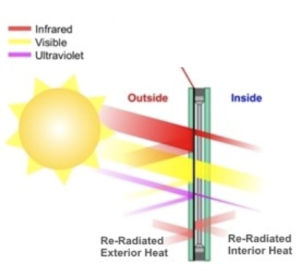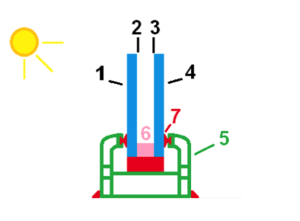Glazing

Glazing is the term that describes the transparent material used in windows.[2] Changing the type of glazing, the amount of glazing, or the material placed between layered glazing can greatly affect the energy performance of a window. This is why using different types of glazing or replacing old glazing is a popular way to lower the heat loss of residential windows.
Layered Glazing
In Canada, windows must be at least double glazed meaning they consist of two panes of glazing, usually glass. However, single glazed windows are used in older buildings here and in other parts of the world. Triple and quad glazed windows are also used, but are uncommon, due to their high expense. A spacer is placed between the panes to seal the area between the glass. To help reduce heat transfer the spacer can be made from a less conductive material such as structural foam.[3] The space between the glazing is usually filled with air or an inert gas such as argon. The figure below shows a typical cross section of a double glazed window.

| Number | Part |
|---|---|
| 1 | Outer side of exterior glazing (exposed to environment) |
| 2 | Inner side of exterior glazing |
| 3 | Inner side of interior glazing |
| 4 | Outer side of interior glazing (exposed to the home) |
| 5 | Window frame |
| 6 | Spacer |
| 7 | Sealant |
The main benefit of having windows that contain double glazing or more is their improved insulation properties. Having two separate panes of glass helps to keep the innermost pane closer to room temperature ensuring that someone sitting next to the window will be affected less by the exterior temperature. This also prevents heat loss from the house, improving thermal efficiency.
Low emissivity coating
One of the main types of glazing that can greatly reduce the heat loss in windows is known as low emissivity coating (low-e coating). It is a fine metal coating that reduces heat gain in the summer and heat loss in the winter. It works by reflecting the heat from the sources back to its original source.[4] Low-e coatings reduce the amount of ultraviolet (UV) and infrared radiation (IR) emitted through the glazing. In the summer, the low-e coating will reduce solar heat gain through the windows. In contrast, in the winter, the low-e coating will reduce the amount of infrared radiation emitted from the interior of the home to the external environment. The unique thing about low-e glazing is that while it reduces the amount of UV and infrared radiation emitted through the window, it still allows the visible light from the sun to pass through a window.[5]
An easier way to understand how it works is by thinking of how a thermos works. A thermos has a silver lining that keeps on reflecting the temperature of the liquid inside to keep it warm. This constant reflection along with the space between the outer wall and the inner wall of the thermos maintain the temperature inside the thermos. [5] From this we can see that a thermos applies both the concepts behind low-e coatings and double paned glazing.
Drawbacks
A potential drawback for any of these glazing techniques is their high initial cost. However, that being said if installed properly they will save the user money in the long run by decreasing their energy bills from heating and cooling.[6]
For Further Reading
- Insulation
- E-coating
- R-value
- Curtain
- Or explore a [random page]
References
- ↑ ITI Glass "Low-E Glass" [Online]. Available: http://www.itiglass.com/glass/?id=8
- ↑ Natural Resources Canada "Energy-Efficient Residential Windows, Doors and Skylights" [Online]. Available:http://oee.nrcan.gc.ca/sites/oee.nrcan.gc.ca/files/files/pdf/equipment/windows-door-skylights-e-web-version.pdf
- ↑ 3.0 3.1 Wikipedia "Insulated Glazing" [Online]. Available:http://en.wikipedia.org/wiki/Insulated_glazing
- ↑ Whistler Glass "Low-E Glass?" [Online]. Available: http://whistlerglass.com/pages/faq/what-is-low-e-glass.php
- ↑ 5.0 5.1 PPG Ideascape "What is Low-E Glass?" [Online]. Available: http://educationcenter.ppg.com/glasstopics/how_lowe_works.aspx
- ↑ HIpages "What You Need To Know About Double Glazing" [Online]. Available:http://www.homeimprovementpages.com.au/article/what_you_need_to_know_about_double_glazing

